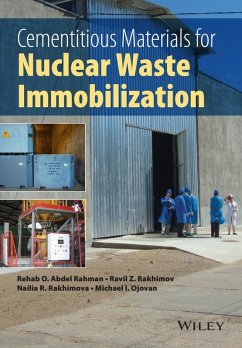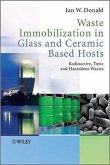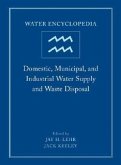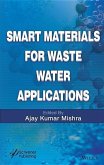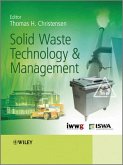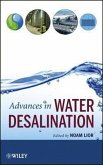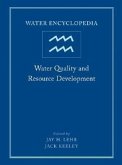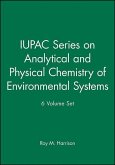Rehab O Abdel Rahman, Ravil Z Rakhimov, Nailia R Rakhimova, Michael I Ojovan
Cementitious Materials for Nuclear Waste Immobilization
Rehab O Abdel Rahman, Ravil Z Rakhimov, Nailia R Rakhimova, Michael I Ojovan
Cementitious Materials for Nuclear Waste Immobilization
- Gebundenes Buch
- Merkliste
- Auf die Merkliste
- Bewerten Bewerten
- Teilen
- Produkt teilen
- Produkterinnerung
- Produkterinnerung
Cementitious materials are an essential part in any radioactive waste disposal facility. Conditioning processes such as cementation are used to convert waste into a stable solid form that is insoluble and will prevent dispersion to the surrounding environment. It is incredibly important to understand the long-term behavior of these materials. This book summarises approaches and current practices in use of cementitious materials for nuclear waste immobilisation. It gives a unique description of the most important aspects of cements as nuclear waste forms: starting with a description of wastes,…mehr
Andere Kunden interessierten sich auch für
![Waste Immobilization in Glass and Ceramic Based Hosts Waste Immobilization in Glass and Ceramic Based Hosts]() Ian W DonaldWaste Immobilization in Glass and Ceramic Based Hosts197,99 €
Ian W DonaldWaste Immobilization in Glass and Ceramic Based Hosts197,99 €![Water Encyclopedia, Domestic, Municipal, and Industrial Water Supply and Waste Disposal Water Encyclopedia, Domestic, Municipal, and Industrial Water Supply and Waste Disposal]() Water Encyclopedia, Domestic, Municipal, and Industrial Water Supply and Waste Disposal677,99 €
Water Encyclopedia, Domestic, Municipal, and Industrial Water Supply and Waste Disposal677,99 €![Smart Materials for Waste Water Applications Smart Materials for Waste Water Applications]() Ajay Kumar MishraSmart Materials for Waste Water Applications234,99 €
Ajay Kumar MishraSmart Materials for Waste Water Applications234,99 €![Solid Waste Technology and Management, 2 Volume Set Solid Waste Technology and Management, 2 Volume Set]() Solid Waste Technology and Management, 2 Volume Set481,99 €
Solid Waste Technology and Management, 2 Volume Set481,99 €![Advances in Water Desalination Advances in Water Desalination]() Advances in Water Desalination236,99 €
Advances in Water Desalination236,99 €![Water Encyclopedia, Water Quality and Resource Development Water Encyclopedia, Water Quality and Resource Development]() Water Encyclopedia, Water Quality and Resource Development673,99 €
Water Encyclopedia, Water Quality and Resource Development673,99 €![Iupac Series on Analytical and Physical Chemistry of Environmental Systems 6 Volume Set Iupac Series on Analytical and Physical Chemistry of Environmental Systems 6 Volume Set]() Roy M HarrisonIupac Series on Analytical and Physical Chemistry of Environmental Systems 6 Volume Set2.876,99 €
Roy M HarrisonIupac Series on Analytical and Physical Chemistry of Environmental Systems 6 Volume Set2.876,99 €-
-
-
Cementitious materials are an essential part in any radioactive waste disposal facility. Conditioning processes such as cementation are used to convert waste into a stable solid form that is insoluble and will prevent dispersion to the surrounding environment. It is incredibly important to understand the long-term behavior of these materials. This book summarises approaches and current practices in use of cementitious materials for nuclear waste immobilisation. It gives a unique description of the most important aspects of cements as nuclear waste forms: starting with a description of wastes, analyzing the cementitious systems used for immobilization and describing the technologies used, and ending with analysis of cementitious waste forms and their long term behavior in an envisaged disposal environment. Extensive research has been devoted to study the feasibility of using cement or cement based materials in immobilizing and solidifying different radioactive wastes. However, these research results are scattered. This work provides the reader with both the science and technology of the immobilization process, and the cementitious materials used to immobilize nuclear waste. It summarizes current knowledge in the field, and highlights important areas that need more investigation. The chapters include: Introduction, Portland cement, Alternative cements, Cement characterization and testing, Radioactive waste cementation, Waste cementation technology, Cementitious wasteform durability and performance assessment.
Hinweis: Dieser Artikel kann nur an eine deutsche Lieferadresse ausgeliefert werden.
Hinweis: Dieser Artikel kann nur an eine deutsche Lieferadresse ausgeliefert werden.
Produktdetails
- Produktdetails
- Verlag: Wiley
- Seitenzahl: 248
- Erscheinungstermin: 10. November 2014
- Englisch
- Abmessung: 244mm x 178mm x 20mm
- Gewicht: 522g
- ISBN-13: 9781118512005
- ISBN-10: 1118512006
- Artikelnr.: 41565389
- Herstellerkennzeichnung
- Libri GmbH
- Europaallee 1
- 36244 Bad Hersfeld
- gpsr@libri.de
- Verlag: Wiley
- Seitenzahl: 248
- Erscheinungstermin: 10. November 2014
- Englisch
- Abmessung: 244mm x 178mm x 20mm
- Gewicht: 522g
- ISBN-13: 9781118512005
- ISBN-10: 1118512006
- Artikelnr.: 41565389
- Herstellerkennzeichnung
- Libri GmbH
- Europaallee 1
- 36244 Bad Hersfeld
- gpsr@libri.de
Rehab O. Abdel Rahman is Nuclear Engineering Lecturer, at the Atomic Energy Authority of Egypt, Cairo, Egypt. He has been working in the field of nuclear engineering for almost 20 years, and has published in several international journals. His areas of research include radioactive waste management: performance assessment, material selection, cementitious material. Ravil Z. Rakhimov and Nailia R. Rakhimova are Professor and Assistant Professor at Kazan State University of Architecture and Engineering, Russian Federation. Ravil has almost forty years' experience of teaching in the fields of materials science and cementitious materials. He is the author of more than 35 patents, 29 monographs and textbooks and nearly 600 papers in Russian. Current research interests include building material science and cementitious materials. Nailia has fifteen years' experience in materials science, and mineral binders. She holds 6 patents, has written one monograph and more than100 papers, mostly in Russian. Michael Ojovan is Assistant Professor at the University of Sheffield, Visiting Professor at Imperial College, London, and Nuclear Engineer at the International Atomic Energy Agency (IAEA), Austria. Prior to this he spent he 20 years at The Moscow Scientific and Industrial Association "Radon", the leading radioactive waste research institution of Russian Federation. He is a Fellow of Russian Academy of Natural Sciences and a Technical Expert of the International Atomic Energy Agency. He has published over 290 peer reviewed scientific papers, 6 books on nuclear materials, 6 book chapters, 14 IAEA documents and has 42 patents. He has also been awarded research grants totalling over £7M.
About the Authors xi
Preface xiii
1 Introduction 1
1.1 Background of Nuclear Waste Problem 1
1.2 Nuclear Industry Facilities 2
1.2.1 NFC Facilities 2
1.2.2 Radioisotope Production and Application 8
1.3 Nuclear Waste Sources and Classification 10
1.4 Nuclear Waste Management 13
1.4.1 Development of Policy Principles, Strategy and Legal Framework 14
1.4.2 Technical Options for a Waste Management System 16
1.4.3 Technical Factors that Affect Technology Selection 22
1.5 Wasteform Materials 23
References 25
2 Cements: Portland Cement 27
2.1 Cements 27
2.2 Portland Cement: Manufacture, Mineral Composition, Properties 28
2.3 Phase and Mineral Composition of Ordinary Portland Cement 30
2.4 Properties of Portland Cement 31
2.5 Hydration of Portland Cement 32
2.5.1 Hydration and Hydraulic Activity of Clinker Phases and Portland
Cement 32
2.5.2 Process Chemistry, Products and Hydration Stages 35
2.5.3 Microstructure, Phases and Properties of Fresh and Hardened Cement
Paste 40
2.6 Interaction of Portland Cements with Water and Soil 44
2.6.1 Ground Waters and Their Interaction with Cement Hydration Products 44
2.6.2 Soil and Its Interaction with Cement Hydration Products 48
References 51
3 Portland Cements with Mineral and Chemical Admixtures 53
3.1 Chemical Admixtures to Control the Structure and Properties of Portland
Cements 53
3.1.1 Accelerators 55
3.1.2 Retarders 56
3.1.3 Plasticizers, Super-Plasticizers and Hyperplasticizers 57
3.2 Mineral Admixtures in the Control of the Composition, Structure and
Properties of Cements 61
3.2.1 Classification of Mineral Admixtures for Cements 62
3.2.2 Portland Cements with Mineral Admixtures from Natural Rocks and
Minerals 66
3.2.3 Portland Cements with Mineral Admixtures from Wastes of Various
Industries 67
3.2.4 Portland Cements with Synthetic Mineral Admixtures 69
3.2.5 Portland Cements with Hybrid Mineral and Organic-Mineral Admixtures
70
References 74
4 Alternative Binders 79
4.1 Calcium Aluminate Cements 80
4.1.1 Chemical and Mineralogical Composition of CACs 80
4.1.2 Hardening of CACs 81
4.1.3 Properties of CACs 82
4.2 Calcium Sulphoaluminate Cements 83
4.2.1 Chemical and Mineralogical Composition of CSACs 84
4.2.2 Hardening of CSACs 84
4.2.3 Properties of CSACs 86
4.3 Phosphate Cements 87
4.3.1 Properties of Phosphate Cements 89
4.3.2 Magnesium Phosphate Cements 90
4.3.3 Calcium Phosphate Cements 90
4.4 Alkali-Activated Cements 92
References 99
5 Cement Properties, Characterization and Testing 105
5.1 Water/Cement Ratio, Water Requirement, Workability and Water Retention
105
5.2 Setting Time 109
5.3 Specific Surface Area and Particle Size Distribution 111
5.4 Heat Evolution 113
5.5 Strength 114
5.6 Freeze-Thaw Resistance 119
5.7 Microstructure and Analysis 121
References 124
6 Radioactive Waste Cementation 127
6.1 Radioactive Waste Streams for Cementation 127
6.2 Liquid Waste 130
6.2.1 Organic Liquid Waste for Cementation 130
6.2.2 Aqueous Waste for Cementation 132
6.3 Bulk Solid Radioactive Wastes 138
6.3.1 Bulk Metallic Wastes 138
6.3.2 Bulk Concrete Wastes 140
6.3.3 Bulk Graphite 142
6.3.4 Bulk Hazardous Wastes 143
6.4 Fragmented (Dispersed) Solid Wastes 143
6.4.1 Compactable, Combustible Wastes 144
6.4.2 Non-compactable, Non-combustible Wastes 145
6.5 Additives for Radioactive Waste Cementation 147
6.5.1 Lime 148
6.5.2 Blast Furnace Slag 149
6.5.3 Clay Minerals 149
6.6 Cement-Based Composite Materials 152
6.7 Cement-Based Wasteform Optimization 153
References 154
7 Waste Cementation Technology 159
7.1 Methods of Liquid Waste Cementation 159
7.1.1 Regular Mixer Technology 161
7.1.2 Disposable Stirrer Technology 163
7.1.3 Slant Mixer Technology 167
7.1.4 High Energy and High Shear Mixer Technology 168
7.1.5 In-line Mixing Technology 168
7.2 Methods for Cementation of Fragmented (Dispersed) Solid Waste 168
7.3 Methods for Cementation of Bulk Solid Waste 173
7.4 Quality Control of Technological Processes and Materials Obtained 174
References 175
8 Cementitious Wasteform Durability 177
8.1 Wasteform Durability Requirements 177
8.2 Role of Material Performance 181
8.3 Expected Performance of Cements 182
8.4 Wasteform Leaching Parameters 185
8.5 Laboratory Tests 186
8.6 Long-Term Field Tests 188
8.6.1 Mound Type Repository Field Tests 189
8.6.2 Vault Repository Field Tests 194
8.7 Effect of Radiation 195
8.8 Biological Effects 196
8.9 Role of Filling Materials 197
References 198
9 Performance Assessment 201
9.1 Historical Disposal Practice 202
9.2 Disposal Facility Design 204
9.2.1 Shallow Land Disposal Options 206
9.2.2 Underground Disposal Option 208
9.3 Modelling Approaches 210
9.4 Performance Assessment 212
9.5 Safety Case 216
References 217
10 Future Trends and Concluding Remarks 221
10.1 Role of Cementitious Materials 221
10.2 Novel Cementitious Materials 222
10.3 Concluding Remarks 224
References 225
Index 227
Preface xiii
1 Introduction 1
1.1 Background of Nuclear Waste Problem 1
1.2 Nuclear Industry Facilities 2
1.2.1 NFC Facilities 2
1.2.2 Radioisotope Production and Application 8
1.3 Nuclear Waste Sources and Classification 10
1.4 Nuclear Waste Management 13
1.4.1 Development of Policy Principles, Strategy and Legal Framework 14
1.4.2 Technical Options for a Waste Management System 16
1.4.3 Technical Factors that Affect Technology Selection 22
1.5 Wasteform Materials 23
References 25
2 Cements: Portland Cement 27
2.1 Cements 27
2.2 Portland Cement: Manufacture, Mineral Composition, Properties 28
2.3 Phase and Mineral Composition of Ordinary Portland Cement 30
2.4 Properties of Portland Cement 31
2.5 Hydration of Portland Cement 32
2.5.1 Hydration and Hydraulic Activity of Clinker Phases and Portland
Cement 32
2.5.2 Process Chemistry, Products and Hydration Stages 35
2.5.3 Microstructure, Phases and Properties of Fresh and Hardened Cement
Paste 40
2.6 Interaction of Portland Cements with Water and Soil 44
2.6.1 Ground Waters and Their Interaction with Cement Hydration Products 44
2.6.2 Soil and Its Interaction with Cement Hydration Products 48
References 51
3 Portland Cements with Mineral and Chemical Admixtures 53
3.1 Chemical Admixtures to Control the Structure and Properties of Portland
Cements 53
3.1.1 Accelerators 55
3.1.2 Retarders 56
3.1.3 Plasticizers, Super-Plasticizers and Hyperplasticizers 57
3.2 Mineral Admixtures in the Control of the Composition, Structure and
Properties of Cements 61
3.2.1 Classification of Mineral Admixtures for Cements 62
3.2.2 Portland Cements with Mineral Admixtures from Natural Rocks and
Minerals 66
3.2.3 Portland Cements with Mineral Admixtures from Wastes of Various
Industries 67
3.2.4 Portland Cements with Synthetic Mineral Admixtures 69
3.2.5 Portland Cements with Hybrid Mineral and Organic-Mineral Admixtures
70
References 74
4 Alternative Binders 79
4.1 Calcium Aluminate Cements 80
4.1.1 Chemical and Mineralogical Composition of CACs 80
4.1.2 Hardening of CACs 81
4.1.3 Properties of CACs 82
4.2 Calcium Sulphoaluminate Cements 83
4.2.1 Chemical and Mineralogical Composition of CSACs 84
4.2.2 Hardening of CSACs 84
4.2.3 Properties of CSACs 86
4.3 Phosphate Cements 87
4.3.1 Properties of Phosphate Cements 89
4.3.2 Magnesium Phosphate Cements 90
4.3.3 Calcium Phosphate Cements 90
4.4 Alkali-Activated Cements 92
References 99
5 Cement Properties, Characterization and Testing 105
5.1 Water/Cement Ratio, Water Requirement, Workability and Water Retention
105
5.2 Setting Time 109
5.3 Specific Surface Area and Particle Size Distribution 111
5.4 Heat Evolution 113
5.5 Strength 114
5.6 Freeze-Thaw Resistance 119
5.7 Microstructure and Analysis 121
References 124
6 Radioactive Waste Cementation 127
6.1 Radioactive Waste Streams for Cementation 127
6.2 Liquid Waste 130
6.2.1 Organic Liquid Waste for Cementation 130
6.2.2 Aqueous Waste for Cementation 132
6.3 Bulk Solid Radioactive Wastes 138
6.3.1 Bulk Metallic Wastes 138
6.3.2 Bulk Concrete Wastes 140
6.3.3 Bulk Graphite 142
6.3.4 Bulk Hazardous Wastes 143
6.4 Fragmented (Dispersed) Solid Wastes 143
6.4.1 Compactable, Combustible Wastes 144
6.4.2 Non-compactable, Non-combustible Wastes 145
6.5 Additives for Radioactive Waste Cementation 147
6.5.1 Lime 148
6.5.2 Blast Furnace Slag 149
6.5.3 Clay Minerals 149
6.6 Cement-Based Composite Materials 152
6.7 Cement-Based Wasteform Optimization 153
References 154
7 Waste Cementation Technology 159
7.1 Methods of Liquid Waste Cementation 159
7.1.1 Regular Mixer Technology 161
7.1.2 Disposable Stirrer Technology 163
7.1.3 Slant Mixer Technology 167
7.1.4 High Energy and High Shear Mixer Technology 168
7.1.5 In-line Mixing Technology 168
7.2 Methods for Cementation of Fragmented (Dispersed) Solid Waste 168
7.3 Methods for Cementation of Bulk Solid Waste 173
7.4 Quality Control of Technological Processes and Materials Obtained 174
References 175
8 Cementitious Wasteform Durability 177
8.1 Wasteform Durability Requirements 177
8.2 Role of Material Performance 181
8.3 Expected Performance of Cements 182
8.4 Wasteform Leaching Parameters 185
8.5 Laboratory Tests 186
8.6 Long-Term Field Tests 188
8.6.1 Mound Type Repository Field Tests 189
8.6.2 Vault Repository Field Tests 194
8.7 Effect of Radiation 195
8.8 Biological Effects 196
8.9 Role of Filling Materials 197
References 198
9 Performance Assessment 201
9.1 Historical Disposal Practice 202
9.2 Disposal Facility Design 204
9.2.1 Shallow Land Disposal Options 206
9.2.2 Underground Disposal Option 208
9.3 Modelling Approaches 210
9.4 Performance Assessment 212
9.5 Safety Case 216
References 217
10 Future Trends and Concluding Remarks 221
10.1 Role of Cementitious Materials 221
10.2 Novel Cementitious Materials 222
10.3 Concluding Remarks 224
References 225
Index 227
About the Authors xi
Preface xiii
1 Introduction 1
1.1 Background of Nuclear Waste Problem 1
1.2 Nuclear Industry Facilities 2
1.2.1 NFC Facilities 2
1.2.2 Radioisotope Production and Application 8
1.3 Nuclear Waste Sources and Classification 10
1.4 Nuclear Waste Management 13
1.4.1 Development of Policy Principles, Strategy and Legal Framework 14
1.4.2 Technical Options for a Waste Management System 16
1.4.3 Technical Factors that Affect Technology Selection 22
1.5 Wasteform Materials 23
References 25
2 Cements: Portland Cement 27
2.1 Cements 27
2.2 Portland Cement: Manufacture, Mineral Composition, Properties 28
2.3 Phase and Mineral Composition of Ordinary Portland Cement 30
2.4 Properties of Portland Cement 31
2.5 Hydration of Portland Cement 32
2.5.1 Hydration and Hydraulic Activity of Clinker Phases and Portland
Cement 32
2.5.2 Process Chemistry, Products and Hydration Stages 35
2.5.3 Microstructure, Phases and Properties of Fresh and Hardened Cement
Paste 40
2.6 Interaction of Portland Cements with Water and Soil 44
2.6.1 Ground Waters and Their Interaction with Cement Hydration Products 44
2.6.2 Soil and Its Interaction with Cement Hydration Products 48
References 51
3 Portland Cements with Mineral and Chemical Admixtures 53
3.1 Chemical Admixtures to Control the Structure and Properties of Portland
Cements 53
3.1.1 Accelerators 55
3.1.2 Retarders 56
3.1.3 Plasticizers, Super-Plasticizers and Hyperplasticizers 57
3.2 Mineral Admixtures in the Control of the Composition, Structure and
Properties of Cements 61
3.2.1 Classification of Mineral Admixtures for Cements 62
3.2.2 Portland Cements with Mineral Admixtures from Natural Rocks and
Minerals 66
3.2.3 Portland Cements with Mineral Admixtures from Wastes of Various
Industries 67
3.2.4 Portland Cements with Synthetic Mineral Admixtures 69
3.2.5 Portland Cements with Hybrid Mineral and Organic-Mineral Admixtures
70
References 74
4 Alternative Binders 79
4.1 Calcium Aluminate Cements 80
4.1.1 Chemical and Mineralogical Composition of CACs 80
4.1.2 Hardening of CACs 81
4.1.3 Properties of CACs 82
4.2 Calcium Sulphoaluminate Cements 83
4.2.1 Chemical and Mineralogical Composition of CSACs 84
4.2.2 Hardening of CSACs 84
4.2.3 Properties of CSACs 86
4.3 Phosphate Cements 87
4.3.1 Properties of Phosphate Cements 89
4.3.2 Magnesium Phosphate Cements 90
4.3.3 Calcium Phosphate Cements 90
4.4 Alkali-Activated Cements 92
References 99
5 Cement Properties, Characterization and Testing 105
5.1 Water/Cement Ratio, Water Requirement, Workability and Water Retention
105
5.2 Setting Time 109
5.3 Specific Surface Area and Particle Size Distribution 111
5.4 Heat Evolution 113
5.5 Strength 114
5.6 Freeze-Thaw Resistance 119
5.7 Microstructure and Analysis 121
References 124
6 Radioactive Waste Cementation 127
6.1 Radioactive Waste Streams for Cementation 127
6.2 Liquid Waste 130
6.2.1 Organic Liquid Waste for Cementation 130
6.2.2 Aqueous Waste for Cementation 132
6.3 Bulk Solid Radioactive Wastes 138
6.3.1 Bulk Metallic Wastes 138
6.3.2 Bulk Concrete Wastes 140
6.3.3 Bulk Graphite 142
6.3.4 Bulk Hazardous Wastes 143
6.4 Fragmented (Dispersed) Solid Wastes 143
6.4.1 Compactable, Combustible Wastes 144
6.4.2 Non-compactable, Non-combustible Wastes 145
6.5 Additives for Radioactive Waste Cementation 147
6.5.1 Lime 148
6.5.2 Blast Furnace Slag 149
6.5.3 Clay Minerals 149
6.6 Cement-Based Composite Materials 152
6.7 Cement-Based Wasteform Optimization 153
References 154
7 Waste Cementation Technology 159
7.1 Methods of Liquid Waste Cementation 159
7.1.1 Regular Mixer Technology 161
7.1.2 Disposable Stirrer Technology 163
7.1.3 Slant Mixer Technology 167
7.1.4 High Energy and High Shear Mixer Technology 168
7.1.5 In-line Mixing Technology 168
7.2 Methods for Cementation of Fragmented (Dispersed) Solid Waste 168
7.3 Methods for Cementation of Bulk Solid Waste 173
7.4 Quality Control of Technological Processes and Materials Obtained 174
References 175
8 Cementitious Wasteform Durability 177
8.1 Wasteform Durability Requirements 177
8.2 Role of Material Performance 181
8.3 Expected Performance of Cements 182
8.4 Wasteform Leaching Parameters 185
8.5 Laboratory Tests 186
8.6 Long-Term Field Tests 188
8.6.1 Mound Type Repository Field Tests 189
8.6.2 Vault Repository Field Tests 194
8.7 Effect of Radiation 195
8.8 Biological Effects 196
8.9 Role of Filling Materials 197
References 198
9 Performance Assessment 201
9.1 Historical Disposal Practice 202
9.2 Disposal Facility Design 204
9.2.1 Shallow Land Disposal Options 206
9.2.2 Underground Disposal Option 208
9.3 Modelling Approaches 210
9.4 Performance Assessment 212
9.5 Safety Case 216
References 217
10 Future Trends and Concluding Remarks 221
10.1 Role of Cementitious Materials 221
10.2 Novel Cementitious Materials 222
10.3 Concluding Remarks 224
References 225
Index 227
Preface xiii
1 Introduction 1
1.1 Background of Nuclear Waste Problem 1
1.2 Nuclear Industry Facilities 2
1.2.1 NFC Facilities 2
1.2.2 Radioisotope Production and Application 8
1.3 Nuclear Waste Sources and Classification 10
1.4 Nuclear Waste Management 13
1.4.1 Development of Policy Principles, Strategy and Legal Framework 14
1.4.2 Technical Options for a Waste Management System 16
1.4.3 Technical Factors that Affect Technology Selection 22
1.5 Wasteform Materials 23
References 25
2 Cements: Portland Cement 27
2.1 Cements 27
2.2 Portland Cement: Manufacture, Mineral Composition, Properties 28
2.3 Phase and Mineral Composition of Ordinary Portland Cement 30
2.4 Properties of Portland Cement 31
2.5 Hydration of Portland Cement 32
2.5.1 Hydration and Hydraulic Activity of Clinker Phases and Portland
Cement 32
2.5.2 Process Chemistry, Products and Hydration Stages 35
2.5.3 Microstructure, Phases and Properties of Fresh and Hardened Cement
Paste 40
2.6 Interaction of Portland Cements with Water and Soil 44
2.6.1 Ground Waters and Their Interaction with Cement Hydration Products 44
2.6.2 Soil and Its Interaction with Cement Hydration Products 48
References 51
3 Portland Cements with Mineral and Chemical Admixtures 53
3.1 Chemical Admixtures to Control the Structure and Properties of Portland
Cements 53
3.1.1 Accelerators 55
3.1.2 Retarders 56
3.1.3 Plasticizers, Super-Plasticizers and Hyperplasticizers 57
3.2 Mineral Admixtures in the Control of the Composition, Structure and
Properties of Cements 61
3.2.1 Classification of Mineral Admixtures for Cements 62
3.2.2 Portland Cements with Mineral Admixtures from Natural Rocks and
Minerals 66
3.2.3 Portland Cements with Mineral Admixtures from Wastes of Various
Industries 67
3.2.4 Portland Cements with Synthetic Mineral Admixtures 69
3.2.5 Portland Cements with Hybrid Mineral and Organic-Mineral Admixtures
70
References 74
4 Alternative Binders 79
4.1 Calcium Aluminate Cements 80
4.1.1 Chemical and Mineralogical Composition of CACs 80
4.1.2 Hardening of CACs 81
4.1.3 Properties of CACs 82
4.2 Calcium Sulphoaluminate Cements 83
4.2.1 Chemical and Mineralogical Composition of CSACs 84
4.2.2 Hardening of CSACs 84
4.2.3 Properties of CSACs 86
4.3 Phosphate Cements 87
4.3.1 Properties of Phosphate Cements 89
4.3.2 Magnesium Phosphate Cements 90
4.3.3 Calcium Phosphate Cements 90
4.4 Alkali-Activated Cements 92
References 99
5 Cement Properties, Characterization and Testing 105
5.1 Water/Cement Ratio, Water Requirement, Workability and Water Retention
105
5.2 Setting Time 109
5.3 Specific Surface Area and Particle Size Distribution 111
5.4 Heat Evolution 113
5.5 Strength 114
5.6 Freeze-Thaw Resistance 119
5.7 Microstructure and Analysis 121
References 124
6 Radioactive Waste Cementation 127
6.1 Radioactive Waste Streams for Cementation 127
6.2 Liquid Waste 130
6.2.1 Organic Liquid Waste for Cementation 130
6.2.2 Aqueous Waste for Cementation 132
6.3 Bulk Solid Radioactive Wastes 138
6.3.1 Bulk Metallic Wastes 138
6.3.2 Bulk Concrete Wastes 140
6.3.3 Bulk Graphite 142
6.3.4 Bulk Hazardous Wastes 143
6.4 Fragmented (Dispersed) Solid Wastes 143
6.4.1 Compactable, Combustible Wastes 144
6.4.2 Non-compactable, Non-combustible Wastes 145
6.5 Additives for Radioactive Waste Cementation 147
6.5.1 Lime 148
6.5.2 Blast Furnace Slag 149
6.5.3 Clay Minerals 149
6.6 Cement-Based Composite Materials 152
6.7 Cement-Based Wasteform Optimization 153
References 154
7 Waste Cementation Technology 159
7.1 Methods of Liquid Waste Cementation 159
7.1.1 Regular Mixer Technology 161
7.1.2 Disposable Stirrer Technology 163
7.1.3 Slant Mixer Technology 167
7.1.4 High Energy and High Shear Mixer Technology 168
7.1.5 In-line Mixing Technology 168
7.2 Methods for Cementation of Fragmented (Dispersed) Solid Waste 168
7.3 Methods for Cementation of Bulk Solid Waste 173
7.4 Quality Control of Technological Processes and Materials Obtained 174
References 175
8 Cementitious Wasteform Durability 177
8.1 Wasteform Durability Requirements 177
8.2 Role of Material Performance 181
8.3 Expected Performance of Cements 182
8.4 Wasteform Leaching Parameters 185
8.5 Laboratory Tests 186
8.6 Long-Term Field Tests 188
8.6.1 Mound Type Repository Field Tests 189
8.6.2 Vault Repository Field Tests 194
8.7 Effect of Radiation 195
8.8 Biological Effects 196
8.9 Role of Filling Materials 197
References 198
9 Performance Assessment 201
9.1 Historical Disposal Practice 202
9.2 Disposal Facility Design 204
9.2.1 Shallow Land Disposal Options 206
9.2.2 Underground Disposal Option 208
9.3 Modelling Approaches 210
9.4 Performance Assessment 212
9.5 Safety Case 216
References 217
10 Future Trends and Concluding Remarks 221
10.1 Role of Cementitious Materials 221
10.2 Novel Cementitious Materials 222
10.3 Concluding Remarks 224
References 225
Index 227

